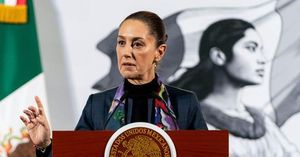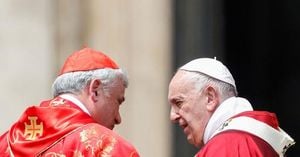Over the past few weeks, Cleveland has found itself embroiled in hot debates over the future home of the Browns, the city’s beloved NFL team. Plans for the Browns to move to a new, state-of-the-art domed stadium have sputtered, with recent announcements causing quite the stir among fans and city officials alike.
Initially, the Browns' ownership proposed relocating to Brook Park, around 15 miles south of downtown Cleveland. Their vision for this $2.4 billion project envisioned not just a football stadium, but also facilities for year-round events and entertainment. The Haslams, who’ve owned the team since 2012, touted the potential of this venture to spur economic development throughout Northeast Ohio, enhancing both job opportunities and local businesses.
Yet, just as the excitement began to build, Cuyahoga County officials wrote to the team’s owners, Dee and Jimmy Haslam, firmly backing the proposal for renovating the current stadium, located right on the lakeshore. Their letter expressed strong hesitation against financing the new stadium project citing concerns over its financial sensibility. "The proposal to build a new stadium does not make fiscal sense for Cuyahoga County residents and taxpayers,” proclaimed County Executive Chris Ronayne and Council President Pernel Jones Jr. "Any proposal... which would create an unacceptable risk to the County’s general fund cannot be considered." This blunt statement certainly marked out the county’s position with respect to the Browns’ ambitious intentions.
To counter the proposed construction, Cleveland Mayor Justin Bibb stepped up with his own ambitious plan: proposing $461 million for renovating the current 65,000-seat stadium, built back in 1999. His plan aims not only to revitalize the existing structure but also to refresh the surrounding area, thereby maximizing the city’s value from its prime lakefront location.
It’s important to note the potent emotional undercurrents woven through this debate. The Browns are not merely one of many sports franchises; they hold deep cultural significance across the region, seen as symbols of Cleveland’s resilience and pride. Their downtown presence fuels local businesses and reflects the urban vitality of the city. Cuyahoga officials highlighted this sentiment effectively, insisting, "The stadium is more than just a venue. The team represents the heart and soul of Northeast Ohio, and reinforces our community's identity and pride.”
Despite the county’s intentions of keeping the Browns downtown, the team appears more inclined to pursue its plans for the new stadium. The Haslams emphasized the complexity of the situation: “a stadium project... takes deep thought, objectivity, innovation, and patience.” They expressed their commitment to gathering more information and options before making any decisions. To them, outright dismissal of the suburban option seemed ill-advised when weighed against the scope of the long-term decision at hand.
While the Browns’ current lease will expire after the 2028 season, they still have some breathing room to negotiate. The push for constructing the dome is compounded by reasonable concerns about funding—whether through community bonds or other means, the financial viability remains cloudy. The Haslams had floated the idea of splitting the funding on the new venue down the middle, with half of the costs covered by private sources and the other half by public funds. This also relates to future revenue generated by the surrounding complex, which suggests additional hotels and retail spaces could sprout around the stadium.
The juxtaposition of these proposals reflects broader trends seen across U.S. cities grappling with the balance between preserving local charm and pursuing large-scale development projects. Cities often wrestle with the need to invest heavily to attract and retain major sports teams, which can be both cost-prohibitive and politically sensitive. City leaders and fans alike are expressed concerns about the intended investments and potential impact on taxpayers: It's no small feat to weigh the long-term advantages against the significant immediate costs.
Public sentiment is as varied as the proposals themselves. Die-hard fans are torn between the excitement of new possibilities and the desire to hold on to cherished memories at the current stadium. A new facility promises modern amenities but at what social and economic cost to the local taxpayer? On one hand, the nostalgic value tied to the existing stadium remains strong; on the other hand, the lure of revitalization is compelling.
Underlying this entire debate is the philosophical question of urban vs. suburban development—whether investing resources toward fostering downtown vibrancy is more advantageous than the promise of new growth extending to suburban locales. It is not merely about where to build but how these decisions influence the character of the greater community. Will Cleveland stand firm with its historical roots, or will it embrace new horizons? Right now, the city appears poised to opt for the route of renovation, nevertheless, the final decision lies with the stakeholders who must navigate the complex web of financial and community interests.
For fans and residents, this situation remains one to watch closely. With the future of the Browns—and potentially significant portions of the city’s urban development—hanging in the balance, both sides appear committed to exploring every available option thoroughly. It's clear there are strong feelings on both sides, and whatever course is taken will have lasting impacts far beyond the lines of the football field.
The coming months will be pivotal as discussions continue, plans evolve, and community voices are heard. It's not just about football anymore; it's about how Cleveland sees itself today and what it envisions for tomorrow. The Haslams, the city officials, and every passionate fan are equally involved in this story, each brandishing their hopes for the team's future and the playground where football dreams can flourish.



